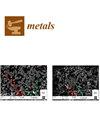陶瓷尺寸和形态对失模铸造 TWIP 钢基复合材料界面粘接性能的影响
IF 2.5
3区 材料科学
Q3 MATERIALS SCIENCE, MULTIDISCIPLINARY
引用次数: 0
摘要
本研究采用消失模铸造技术研究了大型陶瓷增强 TWIP(孪生诱导塑性)钢基复合材料的制造和表征。研究评估了各种形状和尺寸的陶瓷,包括块状、片状、棒状和颗粒状,以确定它们是否适合用作增强材料。研究发现,与块状和片状陶瓷相比,棒状和颗粒状陶瓷具有更好的结构完整性,并能与 TWIP 钢基体形成牢固的界面结合,而块状和片状陶瓷则会出现开裂和碎裂。利用扫描电子显微镜(SEM)和工业计算机断层扫描(CT)进行的详细微观结构分析揭示了影响复合材料形成的机制。结果表明,棒状和颗粒状陶瓷更适合用于增强 TWIP 钢复合材料,可提供出色的机械稳定性和更高的性能。这项研究有助于开发先进的复合材料结构,在需要高强度和耐用材料的行业中具有潜在的应用价值。本文章由计算机程序翻译,如有差异,请以英文原文为准。
Influence of Ceramic Size and Morphology on Interface Bonding Properties of TWIP Steel Matrix Composites Produced by Lost-Foam Casting
This study investigated the fabrication and characterization of large ceramic-reinforced TWIP (twinning-induced plasticity) steel matrix composites using the lost-foam casting technique. Various ceramic shapes and sizes, including blocky, flaky, rod-like, and granular forms, were evaluated for their suitability as reinforcement materials. The study found that rod-like and granular ceramics exhibited superior structural integrity and formed strong interfacial bonds with the TWIP steel matrix compared to blocky and flaky ceramics, which suffered from cracking and fragmentation. Detailed microstructural analysis using scanning electron microscopy (SEM) and industrial computed tomography (CT) revealed the mechanisms influencing the composite formation. The results demonstrated that rod-like and granular ceramics are better for reinforcing TWIP steel composites, providing excellent mechanical stability and enhanced performance. This work contributes to the development of advanced composite structures with potential applications in industries requiring high-strength and durable materials.
求助全文
通过发布文献求助,成功后即可免费获取论文全文。
去求助
来源期刊

Metals
MATERIALS SCIENCE, MULTIDISCIPLINARY-METALLURGY & METALLURGICAL ENGINEERING
CiteScore
4.90
自引率
13.80%
发文量
1832
审稿时长
1.5 months
期刊介绍:
Metals (ISSN 2075-4701) is an open access journal of related scientific research and technology development. It publishes reviews, regular research papers (articles) and short communications. Our aim is to encourage scientists to publish their experimental and theoretical results in as much detail as possible. Therefore, there is no restriction on the length of the papers. The full experimental details must be provided so that the results can be reproduced. Metals provides a forum for publishing papers which advance the in-depth understanding of the relationship between the structure, the properties or the functions of all kinds of metals.
 求助内容:
求助内容: 应助结果提醒方式:
应助结果提醒方式:


